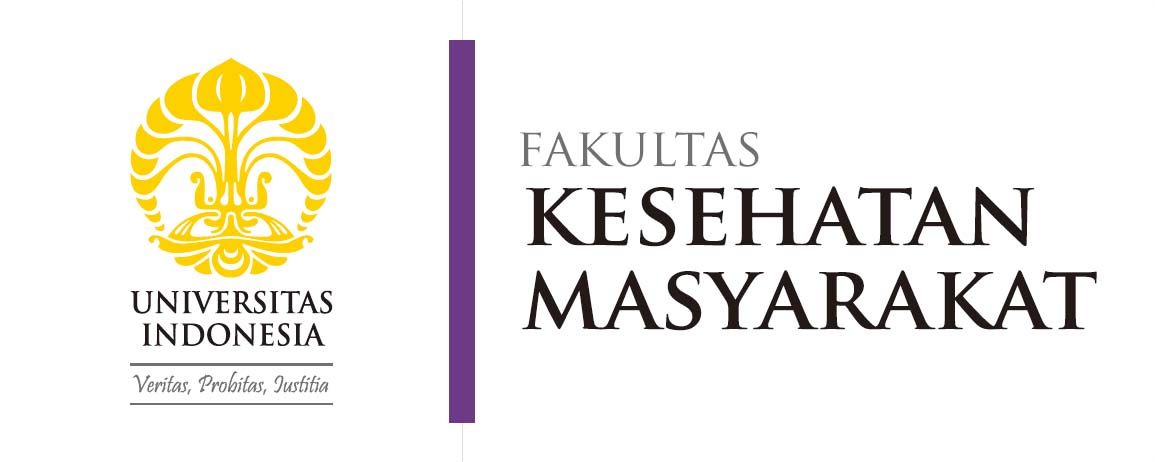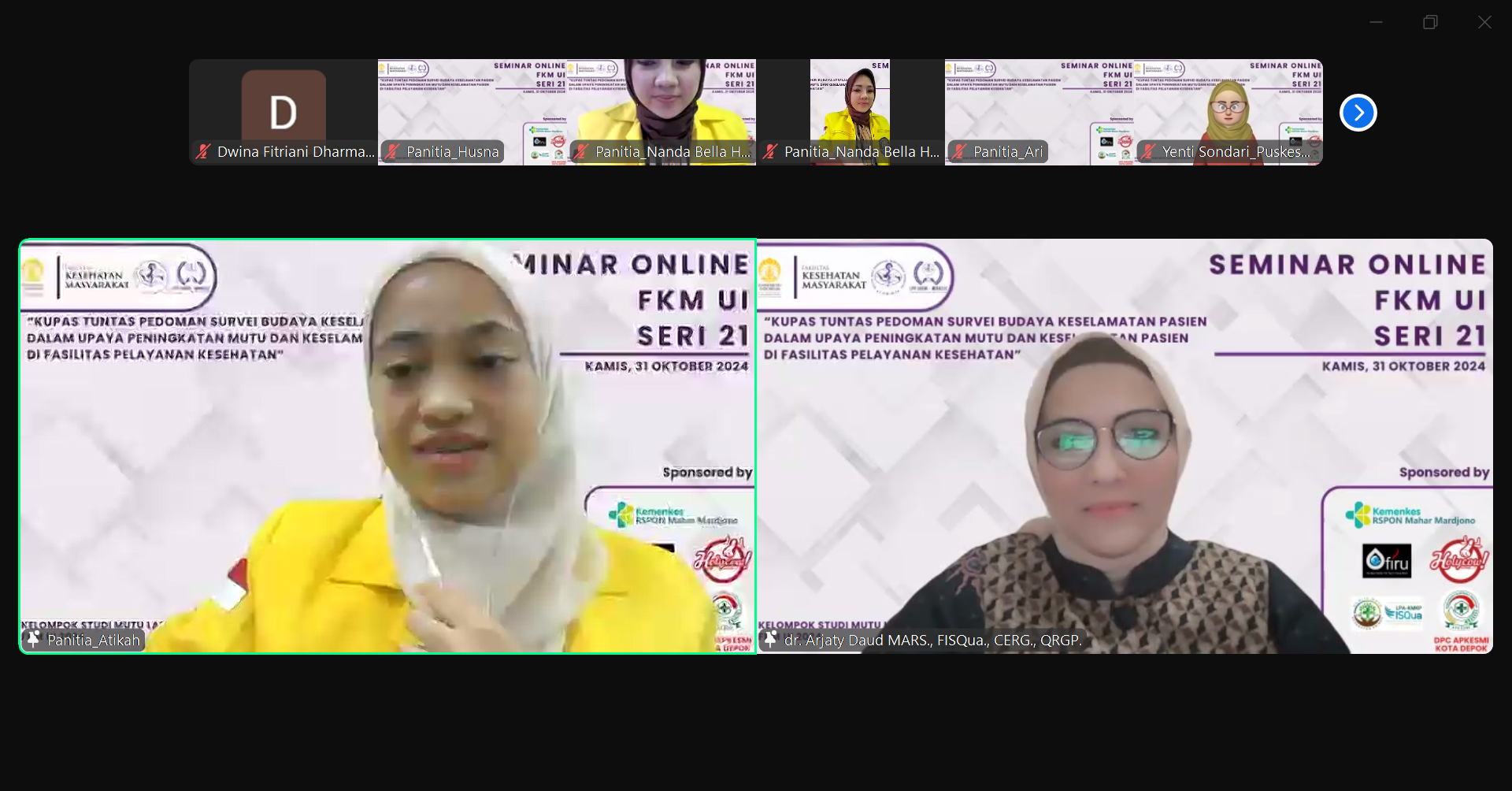The Health Service Quality Study Group of the Postgraduate Faculty of Public Health (FPH) at the Universitas Indonesia (UI) held the 21st series of its Online Seminar (SEMOL) titled “In-Depth Review of the Patient Safety Culture Survey Guidelines in Efforts to Improve Quality and Patient Safety in Health Service Facilities.” The seminar, attended by more than 400 participants, aimed to deepen the understanding of patient safety culture survey guidelines and raise awareness of the importance of patient safety in various health service facilities.
In her opening remarks, the Acting Dean of FPH UI, Dr. Ir. Asih Setiarini, M.Sc., emphasized that patient safety culture is a fundamental pillar of high-quality healthcare services. “It is important for all of us to develop and maintain a safety culture in various healthcare facilities to ensure better and safer services,” said Dr. Asih. Meanwhile, Prof. dr. Adang Bachtiar, M.P.H., D.Sc., Head of the Health Service Quality Study Group, highlighted the additional benefits of implementing a safety culture, particularly for hospitals in Indonesia. “A strong safety culture not only improves service quality but also impacts the financial stability of hospitals, as well as strengthening their reputation and public trust,” he said.
The first speaker, dr. Irna Lidiawati, M.A.R.S., discussed the importance of applying patient safety culture in healthcare services. According to her, safety culture is the foundation for creating a collaborative and respectful work environment, where every team member can work together to solve problems effectively. “Safety culture includes mutual respect, empowering patients and families, and providing psychological protection for the entire team,” explained dr. Irna. Furthermore, she explained that patient safety culture involves continuously evolving behaviors aimed at reducing harm to patients. According to dr. Irna, this culture needs to be seen as a shared attitude and commitment, where all parties are involved in creating a safe environment, both physically and psychologically. She added that healthcare facilities need to encourage every service provider to prioritize teamwork and maintain psychological safety. “This is the key step in ensuring the safety and comfort of patients and staff, while also building trust in the workplace,” she concluded.
In line with this point, Dr. dr. Hervita Diatri, Sp. KJ., Subsp. K(K), Coordinator of the National Sub-Committee for Improving Service Quality at the Ministry of Health, also emphasized the importance of implementing a safety culture. She noted that incident reporting is often still minimal in high-risk units, and stressed the need for a change in reporting culture to improve patient safety. “Understanding values, work behaviors, and equality within teams is a strong foundation for building motivation and reducing negative assumptions in the workplace,” explained dr. Hervita.
Additionally, safety culture also includes protecting staff from violence, including bullying. “We must create a safe environment for all staff, especially those from minority groups or those who have experienced trauma from events such as patient deaths or exposure to hazardous risks,” she added. In this regard, support from supervisors and managers is crucial to promote openness in communication, fostering a safe work atmosphere. “Team effectiveness can be achieved through open communication and smooth shift changes, ensuring that information is well conveyed at all levels,” concluded dr. Hervita.
According to dr. Hervita, staff allocation, work hours, clear task mapping, and competency assessments are essential elements that must be well-maintained. “With fair task distribution and avoiding overlaps, we can ensure that each staff member works within their capacity and expertise,” she explained. Furthermore, dr. Hervita introduced a safety culture framework based on four pillars: just, reporting, informed, and high trust. “A just culture must prioritize honesty and be oriented toward continuous learning. Incidents and quality issues must always be reported,” she said, emphasizing that data and analysis based on standards form the basis for informed decision-making, and high trust is built on openness and appreciation for each staff member’s contribution.
“Not only that, but management support is key to creating an effective patient safety culture,” said dr. Arjaty W. Daud, M.A.R.S., FISQua, CERG, QRGP, Chair of the Clinical Risk Management Institute. According to him, the expectations and actions of supervisors in developing a safety culture are vital, including organizational learning, teamwork, as well as openness and effective communication. Dr. Arjaty also revealed that patient safety culture survey data has been collected annually, with the SOPS Hospital 1.0 database covering between 320 and 1,128 hospitals from 2007 to 2021. The survey involves various respondents, including nurses, doctors, and other staff members.
He suggested that every action plan should be clearly communicated through various methods, such as meetings, newsletters, emails, and bulletin boards. “Communicating action plans and providing regular updates will increase engagement and understanding among all parties,” added dr. Arjaty. “Safe behaviors should be ingrained in everyone’s hearts and minds, wherever and whenever,” he stressed, emphasizing the importance of building a safety culture based on competence, knowledge, skills, and attitude.
As an institution committed to improving public health quality, FPH UI continues to play an active role in educating healthcare professionals in Indonesia. Through SEMOL Series 21, FPH UI seeks to strengthen understanding of patient safety culture and enhance healthcare professionals’ ability to implement safety standards in service facilities. In this way, FPH UI not only leads public health education but also supports efforts to improve healthcare service quality for the safety and well-being of patients. (DFD)

